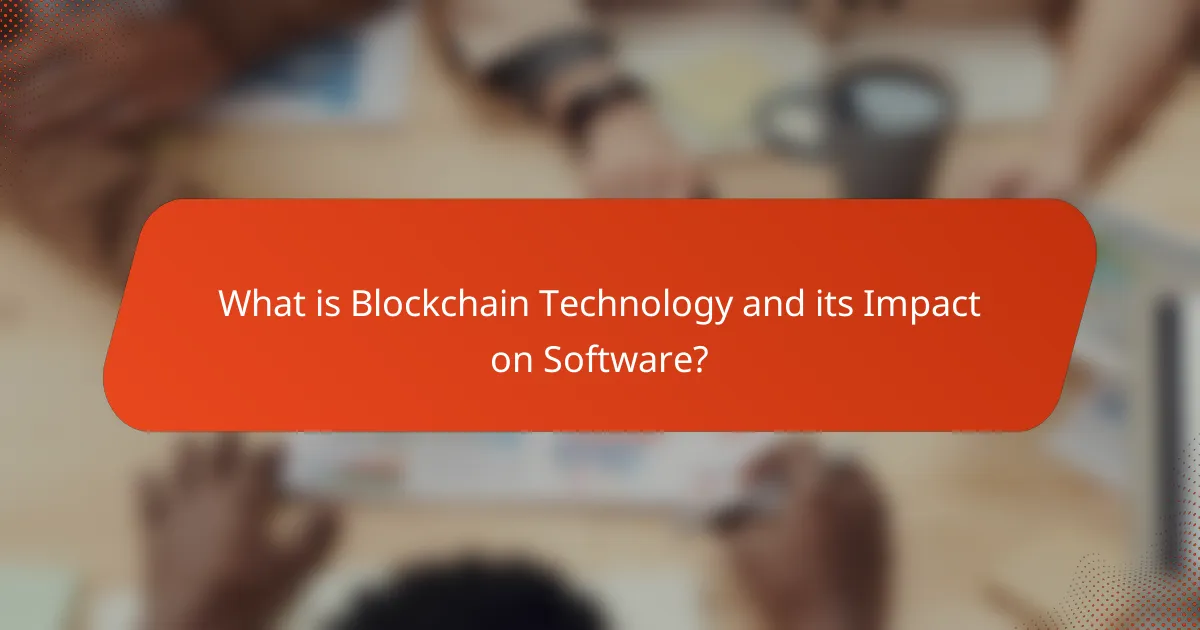Blockchain technology is a decentralized digital ledger that securely records transactions across multiple computers, ensuring transparency and immutability. This article explores the impact of blockchain on software, highlighting its enhanced security, reduced fraud, and increased efficiency by eliminating the need for intermediaries. It discusses the growing interest in blockchain, with 40% of organizations considering its implementation for operational improvements, as noted in a Deloitte report. Additionally, the practical applications of IBM’s blockchain solutions across various industries are examined, showcasing the technology’s scalability and relevance in modern software systems.

What is Blockchain Technology and its Impact on Software?
Blockchain technology is a decentralized digital ledger that securely records transactions across multiple computers. It enables transparency and immutability, preventing unauthorized changes. Each block in the chain contains a list of transactions and a cryptographic hash of the previous block. This structure ensures data integrity and security.
The impact of blockchain on software includes enhanced security, reduced fraud, and increased efficiency. Traditional software systems often rely on central authorities, which can be vulnerable to attacks. Blockchain eliminates the need for intermediaries, streamlining processes.
According to a report by Deloitte, 40% of organizations are considering blockchain for its potential to improve operational efficiency. Additionally, IBM’s blockchain solutions have been adopted across various industries, demonstrating its practical applications.
How does Blockchain Technology function within software applications?
Blockchain technology functions within software applications by providing a decentralized ledger for data storage. This ledger records transactions in a secure and immutable manner. Each transaction is grouped into blocks, which are linked together in chronological order. This structure ensures data integrity and prevents tampering.
Smart contracts, a feature of blockchain, automate processes within applications. They execute predefined conditions without intermediaries. This reduces costs and increases efficiency.
Peer-to-peer networks facilitate direct transactions between users. This eliminates the need for central authorities. Consequently, applications can operate more transparently and securely.
Real-world applications include supply chain management and financial services. These sectors benefit from enhanced traceability and reduced fraud. According to a report by Deloitte, 40% of organizations are exploring blockchain for its potential to improve operational efficiency.
What are the core components of Blockchain Technology?
The core components of blockchain technology include the blockchain itself, consensus mechanisms, smart contracts, and cryptographic security. The blockchain is a decentralized ledger that records all transactions across a network. Consensus mechanisms, such as Proof of Work and Proof of Stake, ensure agreement on the transaction history among network participants. Smart contracts are self-executing contracts with the terms directly written into code. Cryptographic security protects data integrity and privacy within the blockchain. These components work together to create a secure, transparent, and efficient system for recording and verifying transactions.
How do these components interact in software environments?
In software environments, components such as blockchain nodes, smart contracts, and APIs interact to facilitate decentralized applications. Blockchain nodes communicate through a peer-to-peer network, ensuring data consistency and security. Smart contracts automate processes by executing predefined rules when conditions are met. APIs enable external applications to interact with the blockchain, allowing for data retrieval and transaction submission. This integration enhances scalability and security in software applications. Evidence of this interaction can be seen in platforms like Ethereum, where decentralized applications leverage these components for seamless operation.
What are the key applications of Blockchain Technology in software?
Key applications of Blockchain Technology in software include supply chain management, financial services, and healthcare. In supply chain management, blockchain enhances transparency and traceability. It allows all parties to access real-time data about product movement. Financial services utilize blockchain for secure transactions and smart contracts. These features reduce fraud risks and streamline operations. In healthcare, blockchain secures patient data and enables secure sharing among providers. It ensures data integrity and patient privacy. Other applications include identity verification and voting systems. These utilize blockchain’s decentralized nature to enhance security and trust.
Which industries are leveraging Blockchain Technology for software solutions?
Finance, supply chain, healthcare, real estate, and government are industries leveraging Blockchain Technology for software solutions. The finance sector utilizes blockchain for secure transactions and fraud prevention. Supply chain management benefits from enhanced transparency and traceability. In healthcare, blockchain improves patient data management and security. Real estate uses blockchain for property transactions and ownership verification. Governments implement blockchain for secure voting and public records management. Each industry showcases blockchain’s potential to streamline processes and enhance security.
How is Blockchain Technology transforming traditional software models?
Blockchain technology is transforming traditional software models by decentralizing data management. This shift reduces reliance on central authorities. It enhances security through cryptographic techniques. Each transaction is recorded in a tamper-proof ledger. This transparency builds trust among users. Smart contracts automate processes without intermediaries. They execute transactions based on predefined conditions. Furthermore, blockchain increases efficiency by streamlining operations. Companies like IBM and Microsoft are integrating blockchain into their services. This integration showcases its potential to revolutionize industries.
What security advantages does Blockchain Technology provide in software?
Blockchain technology provides enhanced security advantages in software through decentralization, immutability, and cryptographic techniques. Decentralization reduces the risk of a single point of failure. Each participant in the blockchain network holds a copy of the entire ledger. This distribution makes unauthorized data alteration difficult.
Immutability ensures that once data is recorded, it cannot be changed without consensus. Each block is linked to the previous one, creating a secure chain. Altering any block would require changing all subsequent blocks, which is computationally infeasible.
Cryptographic techniques secure data through hashing and encryption. Data is stored in a hashed format, making it unreadable without the correct key. This protects sensitive information from unauthorized access.
According to a study by the World Economic Forum, blockchain could reduce fraud in transactions by up to 80%. These features collectively create a robust security framework for software applications.
How does Blockchain Technology enhance data integrity and security?
Blockchain technology enhances data integrity and security through its decentralized and immutable nature. Each transaction is recorded in a block and linked to the previous block, creating a chain. This structure prevents unauthorized alterations to data. Once a block is added, it cannot be changed without altering all subsequent blocks. This requires consensus from the network, making tampering extremely difficult.
Additionally, blockchain uses cryptographic hashing to secure data. Each block contains a unique hash of the previous block. This ensures that any change in data will result in a different hash, alerting users to potential fraud. According to a report by IBM, blockchain can reduce data breaches by 80% due to its secure structure.
Thus, the combination of decentralization, immutability, and cryptographic security significantly enhances data integrity and security in blockchain technology.
What are common security challenges faced in Blockchain software implementations?
Common security challenges in blockchain software implementations include smart contract vulnerabilities, 51% attacks, and insufficient access controls. Smart contracts can contain coding errors that lead to exploits. For instance, the DAO hack in 2016 resulted from vulnerabilities in its smart contract, leading to a loss of $50 million. A 51% attack occurs when a single entity gains control of the majority of the network’s mining power. This can lead to double-spending and transaction manipulation. Insufficient access controls can expose nodes to unauthorized access, increasing the risk of data breaches. Additionally, phishing attacks targeting users can compromise private keys, leading to unauthorized transactions. Overall, these challenges highlight the need for robust security measures in blockchain implementations.
How does Blockchain Technology address scalability issues in software?
Blockchain technology addresses scalability issues in software through various mechanisms like sharding, layer 2 solutions, and consensus algorithms. Sharding divides the blockchain into smaller, more manageable pieces, allowing parallel processing of transactions. Layer 2 solutions, such as the Lightning Network, enable off-chain transactions, reducing the load on the main blockchain. Additionally, consensus algorithms like Proof of Stake (PoS) enhance transaction speed and efficiency compared to traditional Proof of Work (PoW). According to a study by Ethereum researchers, PoS can increase transaction throughput significantly. These innovations collectively improve the scalability of blockchain networks, making them more suitable for high-volume applications.
What strategies are employed to improve scalability in Blockchain systems?
Strategies employed to improve scalability in Blockchain systems include sharding, layer 2 solutions, and consensus algorithm optimization. Sharding divides the blockchain into smaller, manageable pieces called shards. Each shard processes transactions independently, increasing overall throughput. Layer 2 solutions, like the Lightning Network, facilitate off-chain transactions. This reduces the load on the main blockchain, enhancing speed and efficiency. Consensus algorithm optimization focuses on improving the speed and efficiency of transaction validation. For example, Proof of Stake (PoS) consumes less energy and processes transactions faster than Proof of Work (PoW). These strategies collectively address scalability challenges, enabling blockchain systems to handle higher transaction volumes effectively.
How do scalability challenges differ across various Blockchain platforms?
Scalability challenges vary significantly across different blockchain platforms. Bitcoin faces limitations due to its block size and mining time, leading to slower transaction speeds. Ethereum struggles with high gas fees and network congestion during peak usage. In contrast, platforms like Solana utilize a unique consensus mechanism, allowing for higher throughput and lower costs. Other blockchains, such as Cardano, implement a layered architecture to enhance scalability. Each platform’s approach to scalability affects its overall performance and utility. For example, Bitcoin’s transaction speed is approximately 7 transactions per second, while Solana can handle over 65,000 transactions per second. These differences illustrate how scalability challenges are addressed uniquely across blockchain technologies.
What are the limitations of Blockchain Technology in software applications?
Blockchain technology has several limitations in software applications. One significant limitation is scalability. Most blockchain networks struggle to process a high volume of transactions quickly. For instance, Bitcoin can handle approximately 7 transactions per second, while Ethereum processes around 30 transactions per second. This is inadequate for applications requiring high throughput.
Another limitation is energy consumption. Blockchain networks, especially those using proof-of-work consensus mechanisms, consume vast amounts of energy. The Bitcoin network, for example, is estimated to use more energy than entire countries. This raises concerns about environmental sustainability.
Additionally, blockchain technology faces regulatory challenges. Many jurisdictions have unclear regulations surrounding blockchain applications. This uncertainty can hinder adoption and integration into existing systems.
Moreover, interoperability is a significant issue. Different blockchain networks often cannot communicate with each other. This lack of standardization can limit the functionality of applications that rely on multiple blockchains.
Lastly, there are security vulnerabilities. While blockchain is generally secure, it is not immune to attacks. For instance, 51% attacks can compromise the integrity of a blockchain if a single entity gains control over the majority of the network’s mining power. This poses risks for applications relying on blockchain for security.
How do these limitations impact the adoption of Blockchain in software?
Limitations of blockchain technology significantly hinder its adoption in software. Scalability issues restrict transaction speed and volume, leading to delays in processing. Security concerns, such as vulnerability to attacks, create hesitation among potential users. High energy consumption associated with certain consensus mechanisms raises environmental concerns. Interoperability challenges prevent seamless integration with existing systems. Regulatory uncertainties create apprehension among businesses regarding compliance. These factors collectively contribute to a cautious approach towards implementing blockchain solutions in software development.
What are potential solutions to overcome these limitations?
Enhancing blockchain scalability can be achieved through various methods. Layer 2 solutions, such as the Lightning Network, allow faster transactions by processing them off the main blockchain. Sharding divides the blockchain into smaller, manageable pieces, enabling parallel processing. Increasing block size can accommodate more transactions per block, improving throughput. Implementing consensus algorithm improvements, like Proof of Stake, can enhance transaction speed and energy efficiency. Utilizing sidechains allows for transactions to occur independently while maintaining security with the main chain. These solutions have been validated by projects like Ethereum 2.0 and Bitcoin’s ongoing scalability discussions, demonstrating their practical application in overcoming blockchain limitations.
How can businesses effectively implement Blockchain Technology in their software?
Businesses can effectively implement Blockchain Technology in their software by following a structured approach. First, they should identify specific use cases where blockchain can add value. This could be in areas like supply chain management, data security, or transaction processing. Next, businesses need to select the appropriate blockchain platform. Options include Ethereum, Hyperledger, or private blockchains, depending on their requirements.
After selecting a platform, companies should focus on integrating blockchain with existing systems. This involves ensuring compatibility with current software and databases. Additionally, it is crucial to develop a clear governance model. This model should outline roles, responsibilities, and decision-making processes.
Furthermore, businesses must prioritize security measures. Implementing encryption and access controls can safeguard sensitive data. Testing the blockchain solution is also essential. Conducting pilot projects allows businesses to identify potential issues before full deployment.
Finally, ongoing education and training for staff are necessary. This ensures that employees understand the technology and can leverage its benefits effectively. By following these steps, businesses can successfully implement blockchain technology in their software systems.
What best practices should be followed during Blockchain implementation?
Define clear objectives for blockchain implementation. This ensures alignment with business goals. Conduct a thorough needs assessment before starting. Identify specific use cases that benefit from blockchain technology. Choose the right blockchain platform based on requirements. Evaluate factors like scalability, security, and community support. Ensure stakeholder engagement throughout the process. This promotes collaboration and addresses concerns early. Implement robust security measures from the start. Protect data integrity and user privacy effectively. Establish a governance framework for decision-making. This helps manage changes and maintain compliance. Test the system extensively before full deployment. Pilot programs can reveal potential issues and improve functionality. Monitor performance continuously after implementation. This allows for timely adjustments and optimizations.
What are the common pitfalls to avoid when integrating Blockchain into software?
Common pitfalls to avoid when integrating Blockchain into software include overestimating its benefits. Many developers assume Blockchain will solve all problems, which is often not the case. Another pitfall is neglecting scalability issues. Blockchain networks can face performance limitations as they grow. Additionally, failing to understand regulatory implications can lead to compliance issues. Security misconfigurations are also a frequent concern, as improper setups can expose vulnerabilities. Lastly, underestimating the complexity of integration can result in project delays and increased costs. These pitfalls can hinder the successful implementation of Blockchain technology in software.
Blockchain technology serves as a decentralized digital ledger that enhances security, transparency, and efficiency in software applications. This article explores its core components, including consensus mechanisms and smart contracts, and highlights key applications across various industries such as finance, healthcare, and supply chain management. Additionally, it addresses scalability challenges, security advantages, and common pitfalls in blockchain implementation, providing a comprehensive overview of how blockchain technology is transforming traditional software models. Insights into effective strategies for integrating blockchain into business processes are also discussed, emphasizing the importance of careful planning and security measures.




